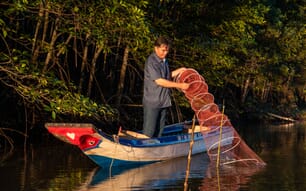Introduction
The EU’s Blue Growth Strategy1 identifies aquaculture — the farming of fish, shellfish and aquatic plants — as a sector which could boost economic growth across Europe and bring social benefits through new jobs. The reformed Common Fisheries Policy2 also aims to promote the sector and EU Member States are currently developing national aquaculture strategies.
Presently, a quarter of seafood products consumed in the EU (including imports) are produced on farms; in 2011, 1.24 million tonnes of aquaculture goods were produced in the EU, worth €3.51 billion (European Commission, 2014a). There are over 14 000 aquaculture enterprises in the EU, directly employing 85 000 people in total (European 3 Commission, 2014b). In contrast with other regions of the world, aquaculture production is stagnating in the EU, while imports are rising.
At the same time, there is a growing gap between the amount of seafood consumed in the EU, and the amount caught from wild fisheries. The European Commission calls for this gap to be partly filled with environmentally responsible aquaculture (European Commission, 2013). Aquaculture thus has an important role to play in Europe’s food security as well as its economic growth.
In its expansion, aquaculture must continue to respect environmental legislation. This report outlines research into a selection of water and ecological impacts of aquaculture, alongside information on existing and forthcoming measures to mitigate negative impacts. It also highlights the possibility that filling certain knowledge gaps could help to further improve aquaculture’s sustainability.
In some cases, aquaculture may have positive effects on nature and water quality, and it has been suggested that certain types of farming could help meet the goals of environmental legislation. The importance for the industry of water quality in the wider environment is also considered.
Aquaculture is a hugely diverse industry (see Box 1), and it should be emphasised that environmental impacts cannot be generalised across the sector. Impacts vary with species, farming methods and management techniques, precise location and local environmental conditions and wildlife.
Aquaculture and EU policy
Aquaculture’s environmental impacts are regulated under a range of EU legal requirements that address broader issues including water quality, biodiversity protection and sustainable development and planning. Both its impacts and regulations are often interrelated. For instance, water pollution from aquaculture operations may affect biodiversity.
Research presented in this report is relevant to current EU legal requirements affecting aquaculture. These include the following.
- The Marine Strategy Framework Directive (MSFD) requires EU Member States to achieve 'Good Environmental Status' for their marine waters by 2020, as judged against a range of 11 so-called 'descriptors'. Thus, national aquaculture strategies must ensure that aquaculture does not have negative impacts in terms of non-indigenous species, eutrophication, seafloor integrity, concentrations of contaminants (both in the water generally and in seafood specifically), populations of commercial fish or marine litter.
- The Water Framework Directive (WFD) addresses pollution and biodiversity concerns in inland, coastal and transitional waters (e.g. estuaries and fjords). It requires Member States to attain ‘good ecological status’ and ‘good chemical status’ in these waters. Pollution by ‘priority’ chemical substances, some of which are used in aquaculture, must be progressively reduced and, in some cases, phased out completely.
- Aquaculture operations must respect wildlife protection requirements under the Birds and Habitats Directives . In particular, they must comply with the conservation objectives of sites included in Natura 20007 , the EU network of protected areas, and be subject to an Appropriate Assessment prior to authorisation in line with Article 6 of the Habitats Directive.
- The Regulation on the use of alien and locally absent species in aquaculture addresses the movement of alien species for aquaculture purposes. Operators must conduct prior risk assessments and obtain permits to transfer alien aquatic species. The newly adopted EU Regulation on the prevention and management of the introduction and spread of invasive alien species will also apply to aquaculture. It will address threats posed by invasive alien species through actions which: (1.) restrict the introduction and spread of invasive alien species; (2.) establish effective early warning and rapid reaction mechanisms; and (3.) manage invasive alien species that are already present and widespread in the EU. It will be compatible with the Regulation on the use of alien and locally absent species in aquaculture.
- Planning and development of new aquaculture sites fall under the Environmental Impact Assessment (EIA) and Strategic Environmental Assessment (SEA) directives. These allow environmental concerns to be taken into account very early on in planning processes, thus avoiding or minimising negative impacts. In addition, the recently-agreed Directive on Maritime Spatial Planning (MSP) aims to promote sustainable development and use of marine resources, including for aquaculture, through Maritime Spatial Plans to be established in each Member State by 2021.




